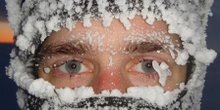Drake's Passage and beyond
The fair breeze blew, the white foam flew,
The furrow followed free;
We were the first that ever burst Into that silent sea.
Cape Petrels in Drake's Passage

It has been only a three day sail from the Falklands to Signy, south into the Antarctic. Though there were no icebergs, this was made up for by the abundance of albatross. There were even a few Wandering Albatross, the bird with the world's greatest wingspan but now heavily threatened by long-line fishing (more info). Bird Island, our next call after Signy, forms an important nesting point for these enormous birds which can soar hundreds of miles with minimal exertion.
At length did cross an Albatross,
Thorough the fog it came ;
At length did cross an Albatross,
Thorough the fog it came ;
Black-browed (l) and Wandering (r) Albatross

However, the appearance of icebergs was announced in the early hours of the day of our arrival at Signy as I was woken by a resounding judder as we hit the first of our sea-ice. Like a group of small children there was an excited rush to the decks with cameras and warm clothing; it has quickly changed from the shorts and sandals that were de rigeur only a week or so ago.
Signy Research Station

Signy is a small sub-Antarctic island that forms, along with Coronation Island, part of the South Orkney Islands, at the tip of the Antarctic peninslua, lying within the British Antarctic Territory. It now forms a summer-only station and is a site for mainly biological science research. It has no doctor, so part of my role is to deal with any medical problems that have arisen and ensure the medical and emergency supplies are adequately stocked.
Coronation Island (click on photo to enlarge)

Photoquiz time, what is odd about the photo below? There is a picture clue at the end of the blog entry.
Work at Signy

Gourlay Peninsula (the hut lies to the far left of the picture)

Nesting Chinstrap Penguins

Adélie Penguins

Elephant Seals at Work

Signy Research Station

Signy is a small sub-Antarctic island that forms, along with Coronation Island, part of the South Orkney Islands, at the tip of the Antarctic peninslua, lying within the British Antarctic Territory. It now forms a summer-only station and is a site for mainly biological science research. It has no doctor, so part of my role is to deal with any medical problems that have arisen and ensure the medical and emergency supplies are adequately stocked.
Coronation Island (click on photo to enlarge)

With the medical bits of the way, there was plenty of other work to help out with. Though the base had been running for a while, the ship calls to re-supply with fuel and food, as well as bringing a large team to blitz major maintenance projects.
Photoquiz time, what is odd about the photo below? There is a picture clue at the end of the blog entry.
Work at Signy

I, along with a group of other FIDS ended up helping to transport the components for a large shed on the Gourlay Peninsula a site of several large penguin colonies, where the shed is used as a base for the science that takes place there. This involved insertion by Tula (the Shackleton's cargo tender), then hard physical labour over the rocks and up a hillside. Hard exercise and work is more than welcome after being cooped up in a ship, all the more so surrounded by thousands of penguins, however foul smelling. We were fortunate that Mike, one of the BAS penguin scientists, gave us a tour round the work they do and the two different penguin species on the peninsula, before being taken out by boat again.
Gourlay Peninsula (the hut lies to the far left of the picture)

Nesting Chinstrap Penguins

Adélie Penguins

Having successfully completed most of the work, we sail north again to Bird Island. Though this may seem paradoxical, the sea ice that forms in the Weddell Sea is almost impenetrable, so the ship will head a long way east over the next few weeks before cutting back in to reach Halley. Follow the ship's daily progress here. As for the photoquiz, the resident elephant seals are camouflaged well against all the cement and building debris.
Elephant Seals at Work


